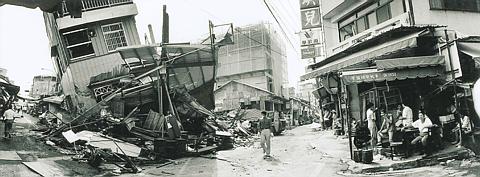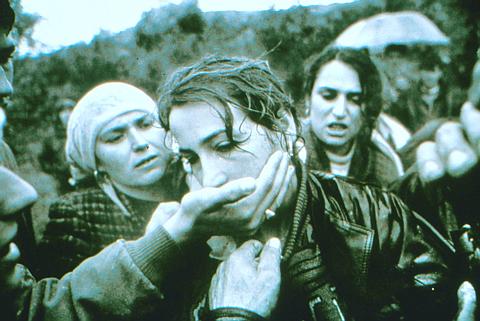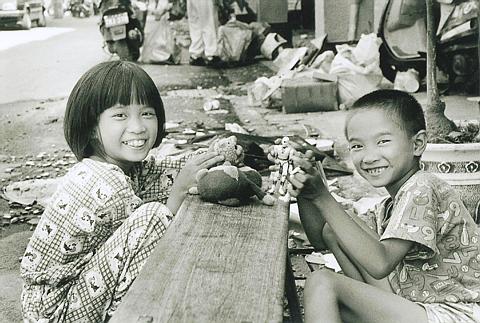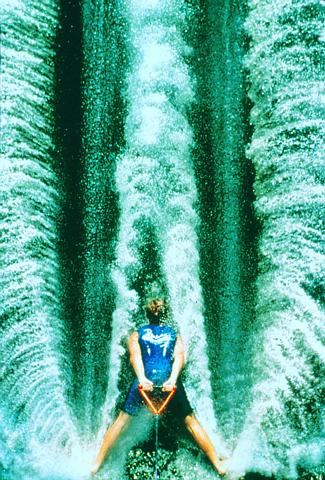For his project on New York's Chinatown, Taiwanese photographer Chang Chien-chi (
Chang's dedication and the power of his images, some of which were published in Time, earned him a first-place award in the daily-life category from the World Press Photo Foundation and inclusion in the foundation's international exhibition of the winning photography.
The show opens to the public at the Taiwan Museum in Taipei today.

921 STREET SCENE BY LIU ZHEN-HSIANG, TAIWAN (ASSOCIATED EXHIBIT)
The exhibition, which stopped in such places as Rome, Paris and New York before arriving in Taipei, will give Taiwan residents a chance to view some of the best press and documentary photography created around the world last year. An adjacent exhibition will display some of the best press photography from the recent 921 earthquake.
The World Press Photo show includes 200 photos selected from nine different categories, ranging from spot news to sports and documentary photography to arts coverage. The winning photos were chosen from among 37,000 images submitted by 3,700 photographers in 116 countries. Together, they comprise something of a historical photographic document.
The annual World Press Photo yearbook has been in Taipei bookstores for months, but the sheer size of the photos in the show create a more powerful experience. The images range from the horrifying to the ridiculous to the sublime. There is a corpse being dragged through the street and beheaded in Indonesia. There is a ludicrous picture of pop singer Bj顤k. There is an intimate photo essay on the life of 14-year-old musical prodigy Pierre Constant, the first African-American to receive a scholarship to the pre-college division of the Juilliard School.

Taken together, they further the foundation's mission of bringing photojournalism and documentary photography to a wider audience, especially in an age when video news coverage competes with traditional photojournalism for people's attention. More than a million people in 35 countries viewed last year's exhibition.
Marieke Wiegel, project manager for the World Press Photo Foundation, says singular images still have the power to define the times we live in. Wiegel points to the enduring images from Vietnam -- especially the naked girl running from a napalm attack -- as proof that "images play a big role in people's historical view."
While many US newspapers have reduced their commitment to photographic projects, in terms of newsprint, staffing and other resources, Wiegel says things are different in Europe, where some of the world's best press and documentary photography is finding a wider audience in mass-circulation publications.

"In Europe, they're using photography to sell newspapers, so they spend a lot of money on it and buy a lot of pictures," she says. "In the future, the role of picture editors will be very important" to furthering the cause of press and documentary photography.
The show will allow Taiwan residents to view some of the work of native son Chang, who is quickly becoming one of the most acclaimed photographers working today. It's been a good year for Chang. He was named America's Magazine Photographer of the Year by the National Press Photographer's Association, and received the prestigious W. Eugene Smith Memorial Fund award.
A graduate of Soochow University, Chang worked for the Seattle Times and later the Baltimore Sun before joining the internationally renowned Magnum Photos agency. His work appears in such publications as Time, Life and National Geographic.

Chang may be the most acclaimed of Taiwanese photographers, but a wide range of Taiwan photojournalists are represented in an exhibit adjacent to the World Press Photo exhibition. Co-sponsored by the Premier Foundation, the exhibit includes 44 photographs taken by 21 Taiwan photographers ? from newspaper veterans to student photographers. The images range from eerie stacks of coffins to daring rescues of children, from crushed temples to children playing with toys amid rubble on their former playground.
"We just wanted to show people what's going on, what happened, every part from the hopeless to the hopeful," Premier's Sarina Yeh (
World Press Photo Exhibition

Oct. 23-Nov. 14.
Taiwan Museum, 2 Hsinyang Road, Taipei. 10am to 5pm. Closed Monday. 2382-2699.

Most heroes are remembered for the battles they fought. Taiwan’s Black Bat Squadron is remembered for flying into Chinese airspace 838 times between 1953 and 1967, and for the 148 men whose sacrifice bought the intelligence that kept Taiwan secure. Two-thirds of the squadron died carrying out missions most people wouldn’t learn about for another 40 years. The squadron lost 15 aircraft and 148 crew members over those 14 years, making it the deadliest unit in Taiwan’s military history by casualty rate. They flew at night, often at low altitudes, straight into some of the most heavily defended airspace in Asia.

This month the government ordered a one-year block of Xiaohongshu (小紅書) or Rednote, a Chinese social media platform with more than 3 million users in Taiwan. The government pointed to widespread fraud activity on the platform, along with cybersecurity failures. Officials said that they had reached out to the company and asked it to change. However, they received no response. The pro-China parties, the Chinese Nationalist Party (KMT) and Taiwan People’s Party (TPP), immediately swung into action, denouncing the ban as an attack on free speech. This “free speech” claim was then echoed by the People’s Republic of China (PRC),

Many people in Taiwan first learned about universal basic income (UBI) — the idea that the government should provide regular, no-strings-attached payments to each citizen — in 2019. While seeking the Democratic nomination for the 2020 US presidential election, Andrew Yang, a politician of Taiwanese descent, said that, if elected, he’d institute a UBI of US$1,000 per month to “get the economic boot off of people’s throats, allowing them to lift their heads up, breathe, and get excited for the future.” His campaign petered out, but the concept of UBI hasn’t gone away. Throughout the industrialized world, there are fears that

Like much in the world today, theater has experienced major disruptions over the six years since COVID-19. The pandemic, the war in Ukraine and social media have created a new normal of geopolitical and information uncertainty, and the performing arts are not immune to these effects. “Ten years ago people wanted to come to the theater to engage with important issues, but now the Internet allows them to engage with those issues powerfully and immediately,” said Faith Tan, programming director of the Esplanade in Singapore, speaking last week in Japan. “One reaction to unpredictability has been a renewed emphasis on